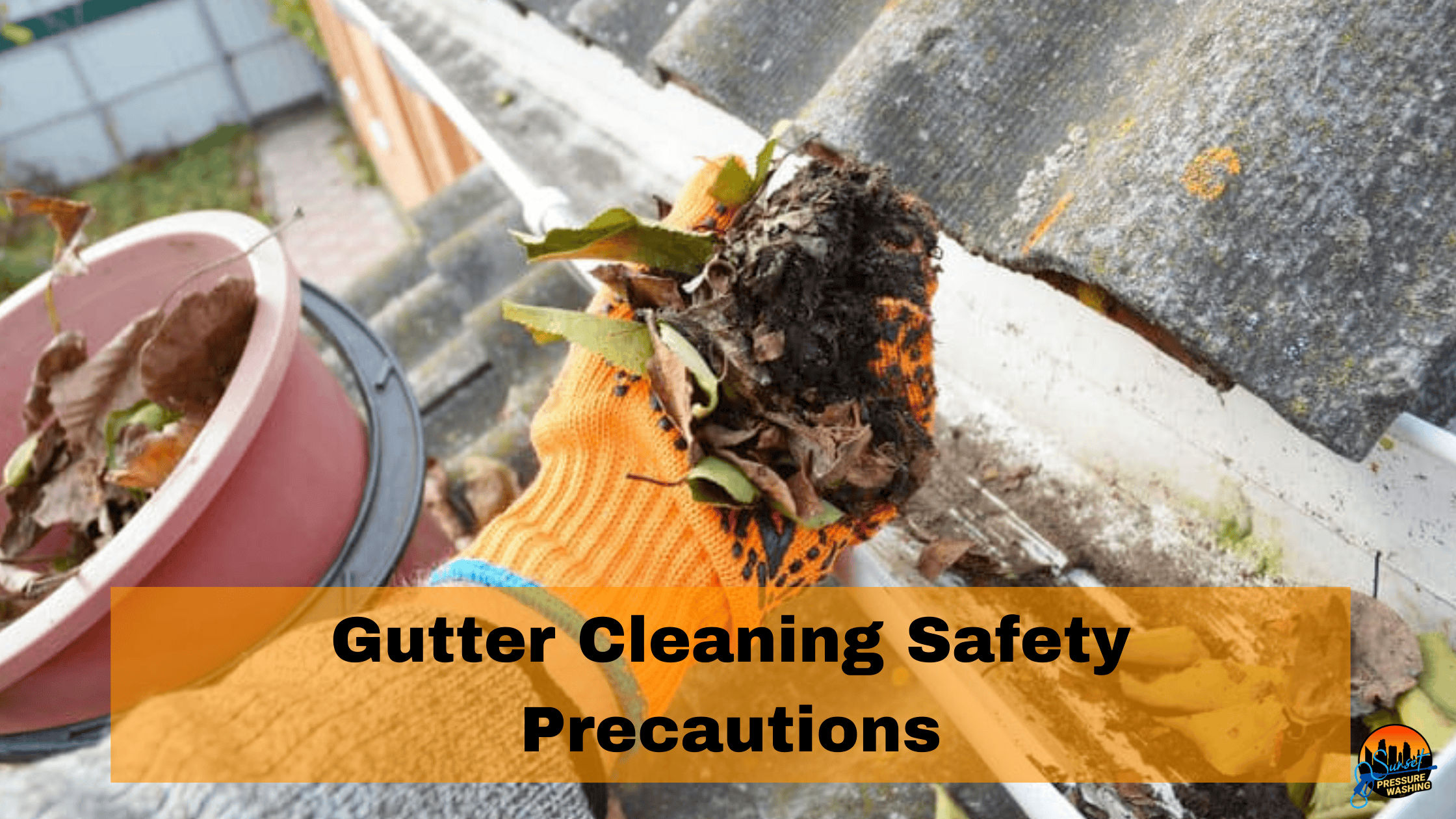
Gutter Cleaning Safety Precautions
Gutter cleaning is an essential home maintenance task that helps prevent water damage, pest infestations, and the deterioration of your home’s foundation. However, it can also be hazardous without the proper precautions. To ensure your safety while performing this task, we’ve compiled a comprehensive guide detailing the necessary safety measures.
Understand the Risks
Cleaning your gutters is not just a simple chore—it involves significant risks that need to be carefully managed to ensure your safety. Being aware of these dangers is the first step toward effective prevention. Here are the primary risks associated with gutter cleaning:
Falls from Heights
One of the most serious risks comes from the use of ladders or accessing the roof. Falls can lead to severe injuries or even fatalities, especially if proper ladder safety protocols are not followed. The height and stability of the ladder, along with your personal comfort and balance while at an elevated height, play critical roles in safety.
Tool and Equipment Mishaps
The tools used in gutter cleaning, such as ladders, scoops, and even garden hoses, can create hazardous situations if they malfunction or are used improperly. For instance, a ladder slipping or collapsing can cause accidents, and improper handling of tools while on the ladder can lead to falls or injuries.
Contact with Dangerous Substances
Gutters often accumulate not just leaves and debris, but also substances like bird droppings and mold, which can be harmful to your health. Direct contact with these substances, without proper protective gear, can lead to infections or allergic reactions.
Electrical Hazards
Overhead power lines near gutters pose a significant risk. Aluminum ladders or other metal tools can conduct electricity, leading to electrocution if they accidentally contact power lines. It’s vital to be aware of the location of power lines before starting the cleaning process.
Insect Bites and Animal Attacks
Gutters can be nesting places for insects and small animals. Disturbing these creatures inadvertently can result in bites or attacks, some of which may require medical attention, especially if allergic reactions occur.
Physical Strain
The physical effort required to clean gutters, which often involves stretching, lifting, and holding awkward positions, can strain muscles and joints. This is particularly a concern for individuals who may not be used to physical labor or who have pre-existing health conditions.
Use the Right Tools
Having the proper tools is crucial not only for effectively cleaning your gutters but also for ensuring your safety during the process. Using the right equipment can minimize your effort, prevent damage to your gutters, and reduce the risk of accidents. Here’s a list of essential tools you should have on hand before you start cleaning your gutters:
Ladders
Choose a sturdy ladder that reaches at least a foot above the gutter to provide stability and ease of access. An extendable ladder is ideal for two-story homes, while a step ladder may be sufficient for a single-story structure. Ensure that the ladder can support your weight along with any tools you might be carrying. Look for ladders with rubber feet to prevent slipping.
Gloves
Thick, durable gloves are necessary to protect your hands from sharp objects and abrasive debris. They should be puncture-resistant to handle thorny branches or jagged edges of metal gutters without tearing. Gloves also provide a better grip on your tools and ladder, enhancing safety.
Goggles
Safety goggles are essential to protect your eyes from dirt, debris, and flying insects. Opt for goggles that fit securely around your eyes and can be worn over glasses if necessary. Ensure they have ventilation to prevent them from fogging up while you work.
Gutter Scoop
A plastic gutter scoop is useful for removing large amounts of debris quickly and efficiently. Plastic is preferable to metal as it is less likely to damage the gutter. The scoop should fit your gutter’s width to clean effectively without causing scratches or dents.
Garden Hose with Spray Nozzle
A garden hose equipped with a spray nozzle can help flush out finer debris and check for proper gutter drainage. Use a nozzle with adjustable settings to control the water pressure, avoiding damage to the gutters while ensuring thorough cleaning.
Ladder Safety
When cleaning gutters, the ladder is often the most critical piece of equipment, as improper use can lead to severe injuries or fatalities. Ensuring ladder safety is a paramount concern, and following these guidelines can help prevent accidents and ensure a secure environment for your maintenance tasks.
Choosing the Right Ladder
Select a ladder that is appropriate for the height you need to reach and has a weight capacity that can support you plus any tools you might carry. For most homes, an extendable ladder made of fiberglass is recommended because it is durable and non-conductive, reducing electrical hazards.
Proper Ladder Setup
- Stable Surface: Always place the ladder on a firm, level surface. Avoid muddy or uneven ground which can cause the ladder to shift or sink during use.
- Correct Angle: The ladder should be positioned at a safe angle. The general rule of thumb is to place its base one foot away from the building for every four feet of ladder height up to the point of contact with the gutter or roof.
- Secure Positioning: If possible, secure the top of the ladder to the gutter or a stable part of the roof. Use a ladder stabilizer to increase the ladder’s stability and to protect the gutters from damage.
Climbing Safely
- Three Points of Contact: Maintain three points of contact with the ladder at all times—two hands and one foot or two feet and one hand. This practice helps stabilize you as you ascend or descend.
- Climb Slowly and Deliberately: Avoid sudden movements or shifts in weight that can destabilize the ladder. Move slowly and deliberately, ensuring the ladder remains stable as you climb.
- Do Not Overreach: Keep your body centered between the rails of the ladder at all times. Do not lean or reach out to the sides as this can cause the ladder to tip over.
Additional Safety Tips
- Inspect the Ladder Before Use: Before climbing, inspect the ladder for any defects, loose parts, or damage. Check the rungs to ensure they are secure and not slippery.
- Avoid Windy or Inclement Weather: Do not use ladders during high winds or storms. Poor weather conditions can significantly increase the risk of accidents.
- Wear Proper Footwear: Wear shoes with non-slip soles to prevent slips and falls. Avoid shoes with thick treads that can get caught in the ladder rungs.
Dismounting
- Stay Focused: Even after you finish the task, maintain focus while descending the ladder. Many accidents occur during the dismount because of a premature shift in attention away from safe practices.
- Keep Hands Free: Avoid carrying tools or debris down the ladder. Use a tool belt or lower tools with a rope.
Check Weather Conditions
Weather plays a significant role in the safety of outdoor maintenance tasks like gutter cleaning. Adverse weather conditions can not only make the job more difficult but also more dangerous. Here are key considerations for checking and understanding weather conditions before you start cleaning your gutters:
Avoid Wet Weather
Cleaning gutters in the rain is not advisable. Wet conditions make ladders slippery, and your footing on the roof or ladder becomes less stable. Moisture can also make debris heavier and harder to remove, increasing the physical strain and the duration of the task.
Beware of Wind
High winds can destabilize a ladder, even one that is well-secured. Wind can also blow debris around, which could get into your eyes or cause unexpected shifts in weight on the ladder. It’s best to choose a calm day for gutter maintenance to avoid these risks.
Check the Temperature
Extremely cold or hot temperatures can affect your ability to work safely. In cold conditions, ice can form on ladders and roofs, creating slippery surfaces, and your manual dexterity can decrease due to cold hands or bulky gloves. In hot weather, you risk heat exhaustion and dehydration, especially when working in direct sunlight for extended periods.
Monitor Weather Forecasts
Always check the local weather forecast before deciding to clean your gutters. Look for a clear, calm day that is forecasted to remain stable without sudden changes in weather conditions. Weather apps and websites can provide hourly forecasts to help you plan the best time for your maintenance work.
Plan for the Best Time of Day
Early morning or late afternoon are usually the best times to undertake gutter cleaning. These periods often have milder temperatures and less intense sunlight, making the work less strenuous and reducing heat-related risks.
Sunlight and Visibility
Ensure you have adequate daylight to see clearly while you work. Poor visibility can increase the risk of accidents, as you may not be able to properly judge distances or see potential hazards. Never attempt to clean gutters in the dusk or when daylight is fading.
Humidity and Dew
Morning dew can make roofs and ladders slick, similar to light rain. If you plan to start early in the day, check surfaces for dew and wait until they are dry. High humidity levels can also make ladder rungs and roofs slippery and uncomfortable to work in.
Clear Work Area
Maintaining a clean and organized workspace is crucial when cleaning gutters, as it not only facilitates efficiency but also significantly enhances safety. A cluttered area can lead to trips and falls, especially when you are moving up and down a ladder. Here are important steps to ensure a clear work area before you begin gutter cleaning:
Remove Ground Obstacles
Inspect the area around your home where you plan to place the ladder and work. Remove any garden tools, children’s toys, or other objects that could be tripping hazards. Ensure that the space is clear of branches, rocks, and garden hoses that might obstruct your pathway or destabilize the ladder.
Secure a Perimeter
If possible, set up a small perimeter around your work area with cones or barrier tape, especially if you are working in a neighborhood where pedestrians might pass close by. This alerts others to the presence of work and helps prevent accidental bumping of the ladder.
Position the Ladder Safely
When setting up your ladder, make sure there is ample space around it. Avoid placing it near doors that might be opened during the cleaning process, as this can destabilize the ladder. Ensure that the ladder’s feet are well-supported on the ground and that it is not leaning on unstable or weak gutter sections.
Manage Debris Efficiently
As you remove debris from the gutters, use a bucket or a bag attached to your ladder to collect it. This prevents debris from falling to the ground where it can create slip hazards or require additional cleanup later. Regularly empty the bucket or bag as it fills to keep your work area tidy and reduce the weight hanging from the ladder.
Use a Buddy System
When undertaking tasks that involve physical risk, such as cleaning gutters, using a buddy system can greatly enhance safety. Having a partner not only provides immediate assistance in case of an accident but also adds an extra layer of precaution throughout the cleaning process. Here’s how implementing a buddy system can be beneficial:
Increased Stability
One of the main advantages of having a buddy is that they can help stabilize the ladder while you climb up and down. This is particularly important when the ground is uneven or when there are no suitable structures to secure the ladder against. A partner can hold the ladder at the base, reducing the risk of it slipping or tipping over.
Immediate Assistance
In case of an accident or emergency, having a buddy ensures that help is immediately available. Whether it’s calling for medical assistance, helping you down from a ladder, or providing first aid, a partner can make a critical difference in response time and the effectiveness of the help provided.
Efficiency in Task Completion
Working with a buddy can make the task more efficient. For example, while one person is on the ladder removing debris from the gutters, the other can manage the disposal of the collected debris, prepare tools, or move the ladder as needed to cover all sections of the gutter. This teamwork speeds up the process and reduces the physical strain on any one individual.
Motivation and Support
Having someone to work with can also provide moral support and motivation. This can make the task less tedious and more enjoyable. Additionally, partners can keep each other in good spirits and maintain high safety standards, reminding each other about best practices as fatigue sets in.
Enhanced Decision-Making
Two heads are better than one when it comes to assessing safety risks and making decisions about how to tackle a task. A buddy can help evaluate whether a plan is safe and offer alternatives if there are potential risks involved. They can also help monitor conditions such as weather changes that might affect safety.
Training and Learning
For those who are less experienced with gutter cleaning, having a more knowledgeable buddy can serve as an opportunity to learn the best practices and safety precautions. This transfer of knowledge helps less experienced individuals become more proficient and safety-conscious over time.
Emotional Security
Lastly, simply knowing that someone is there to watch out for you can provide a sense of security, making it easier to focus on the task without anxiety or fear of what might happen if you were alone.
Wear Appropriate Clothing
The right clothing can make a significant difference in both the safety and ease of gutter cleaning tasks. Wearing appropriate attire helps protect against environmental hazards, ensures mobility, and can prevent accidents. Here’s what to consider when dressing for the job:
Protective Footwear
Footwear is perhaps the most critical element. Choose shoes that provide good grip and stability to prevent slips and falls, especially when climbing ladders or walking on potentially wet surfaces. Shoes should have non-slip soles, ideally made from rubber. Avoid wearing sandals, flip-flops, or any footwear that does not securely enclose your foot.
Durable Work Gloves
Gloves protect your hands from sharp debris, insects, or rough surfaces that could cause cuts or abrasions. They should be thick enough to prevent punctures yet flexible enough to allow easy handling of tools and ladder rungs. Materials like leather or thick, coated fabrics are ideal.
Long Pants and Long-Sleeved Shirts
Wearing long pants and long-sleeved shirts helps protect your skin from scratches, insect bites, and sun exposure. Choose materials that are durable but breathable to maintain comfort while working. Fabrics that dry quickly are preferable, especially if you’re working in the morning when there might be dew.
Eye Protection
Safety goggles or glasses are essential to protect your eyes from flying debris, dust, and dirt that can be dislodged during cleaning. Ensure your eyewear fits well and provides a seal around your eyes. Anti-fog models can be particularly useful to maintain clear vision throughout the task.
Hat and Sunscreen
If you’re working in sunny conditions, wear a brimmed hat to protect your face and neck from sunburn. Apply sunscreen to exposed skin areas to prevent sunburn, which can not only be painful but also distract you from safely completing the task.
Supportive Accessories
Consider additional accessories like knee pads if you need to climb onto the roof or work in uncomfortable positions. A tool belt can also be handy, keeping your tools accessible and allowing you to work more efficiently and safely by keeping your hands free when climbing the ladder.
Avoid Loose Clothing
Loose clothing can catch on ladder rungs, branches, or the rough edges of a roof or gutter. Wear clothes that fit well without being restrictive to your movements. Ensure that any jackets or belts don’t have loose, dangling parts that could pose a risk.
Weather-Appropriate Gear
If you expect cooler weather, dress in layers that you can add or remove as needed. Being too cold or too hot can distract you from your work and increase the risk of accidents. Wear breathable layers that allow perspiration to evaporate to keep your body temperature regulated.
Know When to Hire Professionals
While many homeowners are comfortable performing routine gutter cleaning, there are circumstances where calling in professional help is not only advisable but essential. Recognizing when the risks outweigh the benefits of DIY is key to ensuring both safety and the integrity of your home. Here are several scenarios where you should consider hiring professional gutter cleaners:
High or Inaccessible Gutters
If your home is more than a single story high, the risk associated with cleaning gutters increases significantly. Multi-story buildings often require taller ladders, more complex safety equipment, and a higher level of skill to navigate safely. Professionals have the experience and tools, such as harnesses and specialized ladders, to handle these situations effectively.
Lack of Proper Equipment
Professional gutter cleaners use specialized equipment that most homeowners don’t have. This includes high-grade ladders, gutter vacuums, and water-fed poles that can clean gutters thoroughly from the ground. If you lack the necessary equipment to do the job safely and effectively, it’s best to hire professionals.
Health and Physical Limitations
If you have any health issues or physical limitations that could be exacerbated by the strenuous activity and balancing required for gutter cleaning, it’s safer to opt for professional services. This is particularly important for those who have balance issues, fear heights, or have heart or back problems.
Presence of Damage or Necessary Repairs
If during an inspection, you discover that your gutters are damaged—whether by rust, holes, or broken fasteners—it’s time to call in professionals. They can not only clean your gutters but also repair or replace parts of your gutter system where necessary, ensuring it operates efficiently.
Time Constraints and Convenience
Gutter cleaning can be time-consuming, especially if you’re not doing it regularly. If your schedule doesn’t allow for the time commitment needed to clean your gutters safely and thoroughly, hiring professionals can save you time and hassle. They can perform the job quickly and efficiently due to their expertise and equipment.
Safety Concerns
If you’re uncomfortable with the heights involved or the general task of gutter cleaning, or if you live in a region with unpredictable weather that makes planning safe cleaning difficult, it’s prudent to hire professionals. They are trained to handle adverse conditions and typically have insurance to cover any accidents that might occur.
Dispose of Debris Properly
Proper disposal of debris collected during gutter cleaning is crucial not only for maintaining the cleanliness and safety of your property but also for respecting environmental regulations. Here’s how to responsibly handle the waste from your gutters:
Plan for Debris Collection
Before you begin cleaning, have a plan for where you will collect the debris. Use buckets, heavy-duty garbage bags, or a wheelbarrow to collect the waste as you remove it from the gutters. This approach helps prevent debris from scattering across your yard or garden, which can be unsightly and potentially harmful to the environment.
Use Tarps
Laying tarps on the ground beneath the area where you’re working can make cleanup much easier. As you clear the gutters, any debris that accidentally falls can be easily gathered up with the tarp and then disposed of properly.
Composting Organic Material
Much of the debris from gutters includes organic material such as leaves, twigs, and decomposed organic matter. These can be added to a compost bin if you have one. Composting is an environmentally friendly way to recycle this waste, transforming it into nutrient-rich soil that can be used in your garden.
Check Local Disposal Regulations
Different areas have specific regulations regarding the disposal of waste, including yard debris. Some municipalities offer yard waste collection services, which can be an excellent way to dispose of gutter debris legally and responsibly. Check with your local waste management agency to understand the regulations and services available in your area.
Separate Recyclable Materials
If you find materials that are not biodegradable, such as bits of plastic or metal, separate these from organic waste. Many communities have recycling programs that can process these materials. By recycling, you reduce landfill waste and help conserve resources.
Properly Dispose of Hazardous Materials
Occasionally, you might find hazardous materials in your gutters, such as asbestos (in older homes) or toxic bird droppings. These materials require special handling and disposal methods to avoid health risks. Contact your local waste management services to find out how to safely dispose of hazardous materials.
Wrapping Up Gutter Cleaning Safety Precautions
Ensuring safety during gutter cleaning is paramount for protecting yourself and maintaining the integrity of your home. From choosing the right tools to wearing appropriate clothing and disposing of debris properly, every step in the process requires careful consideration. However, gutter cleaning can be risky and demanding, especially if your home has hard-to-reach gutters or if you have physical limitations.
If the task seems too daunting or if safety concerns arise, don’t hesitate to seek help from professionals. Hiring a gutter cleaning service not only guarantees that the job will be done safely and effectively but also saves you time and prevents potential injuries. Remember, your safety is invaluable—consider contacting a reputable gutter cleaning service today to ensure your gutters are maintained without risk. Book now and take the right step towards a safer and more secure home maintenance routine.






